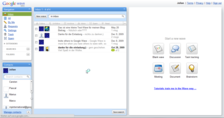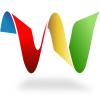Google Wave
| Google Wave
|
|
|---|---|

|
|
| Basic data
|
|
| developer | Google Inc. |
| Current version | switched off |
| operating system | platform-independent (web-based) |
| programming language | Google Web Toolkit , Java |
| License | Apache |
| wave.google.com | |
Google Wave was an online service for communication and collaboration in real time presented by Google Inc. on May 27, 2009 . It consisted of a website and an XMPP -based protocol . Google Wave was developed as an early developer preview version by the two brothers Jens and Lars Rasmussen, who worked at Google Australia and who formed the basis of Google Maps with their own company Where 2 Tech , before they were taken over by Google Inc. in October 2004 has been. Google Wave was realized with the open source programming framework Google Web Toolkit .
Google has announced that it will publish large parts of its own implementation as well as the wave protocol as open source or as an open standard , which will enable the implementation of its own wave systems. In addition, extensions for Google Wave can be written via a programming interface .
On August 4, 2010, Google announced that it would stop developing Wave and close its website towards the end of the year. The source text is to be published and released for further processing. Parts of the previous development should continue to be used in other Google projects.
On March 20, 2012, Google announced that Google Wave would be write-protected and will be shut down on April 30, 2012. Until then, you could still download your content. If you want to keep using Wave, there are some open source projects like Apache Wave .
development
Google Wave was introduced on May 27, 2009 at Google I / O in the Moscone Center in San Francisco by co-developer Lars Rasmussen. He described Google Wave as a mixture of email , chat program , wiki , blog and photo portal. "Two of the most successful ways of digital communication, email and instant messaging, were developed back in the 1960s," said Rasmussen. “Since then, so many different new avenues have been developed - blogs, wikis, collaborative documents, and so on - and computers and networks have improved tremendously. With Google Wave, we're proposing a new way of communicating and collaborating online, where all progress is the starting point. "
The preview of Google Wave started on September 30, 2009. Since May 18, 2010, Google Wave has been accessible to everyone. Previously, participation in the test was only possible by invitation. The service has been discontinued since April 30, 2012 and the Google Wave servers are deactivated.
functionality
Within his wave application (which does not necessarily have to come from Google due to the open protocol), the user can start a wave ( German "Welle"), which can include a topic in a forum , a conversation in instant messaging , one of several e- Mail corresponds to an existing conversation, an article in a wiki or a document. He can then invite other users to collaborate on this wave so that they can also edit or add to the text or media objects it contains. Any user who has opened the wave in their application can follow the changes made by other users in real time and edit them collaboratively (i.e. simultaneously). This enables z. B. a faster conversation while chatting and the simultaneous editing of a document without a version conflict.
At the beginning, in the preview version of the wave protocol, it was only possible to communicate with participants in the same preview action. It is now possible to communicate with the “outside world” via e-mail and Twitter: On the one hand there is the Wave user, on the other hand a familiar e-mail or Twitter account. It is not necessary to take part in the preview for this page; the recipients receive messages as usual. On the wave side, the messages are transferred to the other protocols with the help of plugins, so-called robots .
compatibility
Google's Wave protocol currently has a web interface , along with a few SSB clients. In order for this web interface to be displayed correctly, the browser used for it must support HTML5 and Ajax . Thus are fully compatible:
- Google Chrome
- Firefox 3.5+
- Apple Safari 4+
The browsers on different smartphones are also largely compatible if these browsers are based on the WebKit library. Thus, some are compatible:
WebOS , for which there is no solution yet, and Microsoft's Internet Explorer , for which there is a plug-in called “Google Chrome Frame”, which can add HTML5 support to it later, are not compatible .
Naming
The name refers to the American television series " Firefly - The Dawn of the Serenity ". In the English-language original, electronic communication, which often includes video transmission, is referred to as a "wave". During the presentation of Google Wave, some references to the series were recognizable, including the developer Lars Rasmussen, who replied to a message with the word "shiny", which is used in the series to express enthusiasm or amazement. Another hint is the crash message "Curse your sudden but inevitable betrayal!", Which is also from the series.
Web links
- Official Google Wave server
- Project overview on Wave Protocol at Google Code
- Official Google Wave developer blog
- Google Wave API
- Google Wave Federation Protocol
- Function overview and introduction of Mashable
- Overview of the Google Wave functions (German)
- Google Wave will be discontinued
Individual evidence
- ↑ The apache_wave Open Source Project on Open Hub: Languages Page . In: Open Hub . (accessed on July 18, 2018).
- ↑ TechCrunch (May 28, 2009): Google Wave Drips With Ambition. A New Communication Platform For A New Web.
- ↑ Google Inc. on YouTube (May 28, 2009): Google Wave Developer Preview at Google I / O 2009
- ↑ LeMay, Renai: Google mapper advises: take browsers to the limit . In: CNET . July 29, 2005. Archived from the original on February 2, 2009. Info: The archive link was automatically inserted and not yet checked. Please check the original and archive link according to the instructions and then remove this notice. Retrieved January 8, 2008.
- ↑ googleblog.blogspot.com: “Update on Google Wave” from August 4, 2010, accessed on August 4, 2010
- ↑ Nils Baer: “Wave is not dead: decentralized resurrection of the Google wave” on basic thinking from September 3, 2010, accessed on March 15, 2012
- ↑ ZDNet.de of May 29, 2009: Google shows communication and collaboration service “Google Wave” on: www.zdnet.de . Retrieved November 25, 2009, 1:30 am
- ↑ heise online from May 28, 2009: Google Wave: The real-time wiki communicator at: www.heise.de . Retrieved November 25, 2009, 1:30 am
- ↑ Golem.de (May 28, 2009): Google Wave - the new type of communication
- ↑ Google Wave Blog: Google Wave Available for Everyone
- ↑ http://wave.google.com
- ↑ Email since October 4, 2009, Emaily 0.0.2: Google #Wave now sends email - but lots of work ahead to make it usable , Twitter since the beginning (September 30, 2009)
- ↑ Homepage of the Emaily robot: http://emaily.dlux.hu ( Memento of the original from January 22, 2010 in the Internet Archive ) Info: The archive link was inserted automatically and has not yet been checked. Please check the original and archive link according to the instructions and then remove this notice. and the Tweety robot: wave-samples-gallery.appspot.com ( Memento of the original from March 17, 2010 in the Internet Archive ) Info: The archive link was automatically inserted and not yet checked. Please check the original and archive link according to the instructions and then remove this notice.
- ↑ Article on techcrunch.com , viewed February 5, 2010
- ↑ Google Chrome Frame ( Memento of the original from February 3, 2010 in the Internet Archive ) Info: The archive link was inserted automatically and has not yet been checked. Please check the original and archive link according to the instructions and then remove this notice. , viewed on February 3, 2010
- ↑ From Complete Wave Guide ( Memento of the original dated February 5, 2010 in the Internet Archive ) Info: The archive link was inserted automatically and has not yet been checked. Please check the original and archive link according to the instructions and then remove this notice. , viewed on February 3, 2010
- ^ Nate Cochrane: Opinion: Google's wave drowns the bling in Microsoft's Bing. NextMedia, May 29, 2009, accessed January 15, 2016 .
- ↑ Originally said by the character "Wash" in the episode "Serenity" at timestamp 6:36 when he was playing with miniature dinosaurs. Firefly: The Complete Series (Blu-ray), 2008, 20th Century Fox
